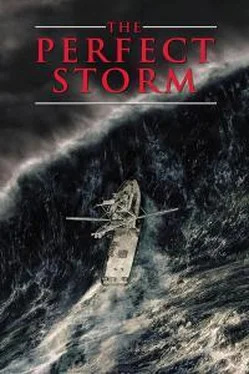Sebastian Junger - The Perfect Storm
Здесь есть возможность читать онлайн «Sebastian Junger - The Perfect Storm» — ознакомительный отрывок электронной книги совершенно бесплатно, а после прочтения отрывка купить полную версию. В некоторых случаях можно слушать аудио, скачать через торрент в формате fb2 и присутствует краткое содержание. Жанр: Триллер, Проза. Описание произведения, (предисловие) а так же отзывы посетителей доступны на портале библиотеки ЛибКат.
- Название:The Perfect Storm
- Автор:
- Жанр:
- Год:неизвестен
- ISBN:нет данных
- Рейтинг книги:3 / 5. Голосов: 1
-
Избранное:Добавить в избранное
- Отзывы:
-
Ваша оценка:
- 60
- 1
- 2
- 3
- 4
- 5
The Perfect Storm: краткое содержание, описание и аннотация
Предлагаем к чтению аннотацию, описание, краткое содержание или предисловие (зависит от того, что написал сам автор книги «The Perfect Storm»). Если вы не нашли необходимую информацию о книге — напишите в комментариях, мы постараемся отыскать её.
The Perfect Storm — читать онлайн ознакомительный отрывок
Ниже представлен текст книги, разбитый по страницам. Система сохранения места последней прочитанной страницы, позволяет с удобством читать онлайн бесплатно книгу «The Perfect Storm», без необходимости каждый раз заново искать на чём Вы остановились. Поставьте закладку, и сможете в любой момент перейти на страницу, на которой закончили чтение.
Интервал:
Закладка:
"Never so much as cracked a pane of glass," he says. "Bigger doesn't always mean better." Eventually he was running four or five sword boats out of Gloucester and pulling in hundreds of thousands of dollars a year. One winter he and his son started accumulating ice on deck on their way back from Georges Bank. "If you're making ice on Georges you know you're going to be in real trouble closer to land," he says. "We went back out and that night it blew a hundred from the northwest and snowed. The wind gauge only goes to a hundred and it was pegged for three days straight—pegged like it was broken. We were in a steel boat and it didn't seem so bad, we were comfortable enough. Steel is tough compared to wood, don't let anyone tell you different. Anyone tells you different, they're a romanticist. Steel goes down faster, though. It goes down . . . well, like a load of steel."
The bad feeling between Bob Brown and the town of Gloucester hit bottom in 1980, when Brown lost a man off a boat named the Sea Fever. The Sea Fever was a fifty-foot wooden boat with a crew of three that was hauling lobster traps off Georges Bank. It was late November and the Weather Service predicted several days of moderate winds, but they were catastrophically wrong. One of the worst storms on record had just drawn a deep breath off the Carolinas. It screamed northward all night and slammed into Georges Bank around dawn, dredging up seventy-foot waves in the weird shallows of the continental shelf. To make matters worse, a crucial offshore data buoy had been malfunctioning for the past two and a half months, and the Weather Service had no idea what was going on out there. The men on the Sea Fever and on another boat, the fifty-five-foot Fair Wind, woke up to find themselves in a fight for their lives.
The Fair Wind got the worse end of the deal. She flipped end over end in an enormous wave and her four crew were trapped in the flooded pilothouse. One of them, a shaggy thirty-three-year-old machinist named Ernie Hazard, managed to gulp some air and pull himself through a window. He burst to the surface and swam to a self-inflating life raft that had popped up, tethered, alongside the boat. The Fair Wind continued to founder, hull-up, for another hour, but the rest of the crew never made it out, so Hazard finally cut the tether and set himself adrift. For two days he scudded through the storm, capsizing over and over, until a Navy P-3 plane spotted him and dropped an orange smoke marker. He was picked up by a Coast Guard cutter and then rushed by helicopter to a hospital on Cape Cod. He had survived two days in his underwear on the North Atlantic. Later, when asked how long it took him to warm up after his ordeal, he said, without a hint of irony,
"Oh, three or four months."
The Sea Fever fared a little better, but not much. She took a huge sea and lost all her windows; the half-inch safety glass burst as if it had been hit by a wrecking ball. The captain, who happened to be Bob Brown's son, turned downsea to avoid any more flooding, but the wave put them on their beam ends and swept one of the crew out of the wheelhouse and over the side. The man's name was Gary Brown (no relation); while one of the remaining crew scrambled below deck to restart the engine, the other threw a lifesaver overboard to save Brown. It dropped right in front of him but he made no attempt to grab it. Brown just drifted away, a dazed look in his eyes.
The other two men called a mayday, and an hour later a Coast Guard helicopter was pounding overhead in the wild dark. By then the two men on board the Sea Fever had righted her and pumped her out. Do you wish to remain with your vessel, or do you wish to be taken off by hoists? the helicopter pilot asked over the radio. We'll stay with the boat, they radioed back. The pilot lowered a bilge pump and then veered back towards shore because he was running out of fuel. On the way back he turned on his "Night Sun” searchlight to look for Gary Brown, but all he could see were the foam-streaked waves. Brown had long since gone under.
Four years later, U.S. District Judge Joseph Tauro in Boston ruled that the National Weather Service was negligent in their failure to repair the broken data buoy. Had it been working, he wrote, the Weather Service might have predicted the storm; and furthermore, they failed to warn fishermen that they were making forecasts with incomplete information. This was the first time the government had ever been held responsible for a bad forecast, and it sent shudders of dread through the federal government. Every plane crash, every car accident could now conceivably be linked to weather forecasting. The National Oceanic and Atmospheric Administration appealed the decision, and it was quickly overturned by a higher court.
None of this was Bob Brown's fault, of course. There's nothing irresponsible about going to Georges in November—he'd done it his whole life, and worse—and the storm was completely unforecast. Moreover, a larger steel-hulled boat sank while the Sea Fever remained afloat; that said a lot about her crew and general state of repair. Still, a man had died on one of Bob Brown's boats, and that was all a lot of people needed to know. A story went around about how Bob Brown once spotted the biggest wave of his life—an enormous Grand Banks rogue—and didn't even stop fishing, he just kept hauling his gear. People started calling him "Suicide" Brown, because working for him meant risking your life. And then it happened again.
It was the mid-eighties and boats were making a million dollars a year. Brown was out on the Grand Banks on the Hannah Boden, and he found himself having to haul back a full set of gear in a sixty-knot breeze. At one point a wave swept the deck, and when the boat climbed back out of the whitewater, two men had gone overboard. They were wearing rain gear and thigh-high rubber boots and could hardly move in the freezing Newfoundland water. One of them went under immediately, but the other man was smashed back against the hull, and a quick-thinking member of the crew extended a gaff hook over the side for him to grab. The hook went through the man's hand, but the situation was too desperate to worry about it and they hauled him on board anyway. They had to steam four hundred miles just to get him to within helicopter range to be taken to a hospital.
Brown's reputation is no concern of Billy's, though. Brown's not on the boat, he's twelve hundred miles away in Gloucester, and if Billy doesn't want him in his life, he just doesn't pick up the radio mike. Furthermore, Billy's making money hand over fist on his boat, and that makes Brown's scruples—or his judgment—or his lack of empathy—all but irrelevant. All Billy needs is five men, a well-maintained boat, and enough fuel to get to and from the Flemish Cap.
The first five sets of Johnston's trip are on what's called the "frontside" of the moon, the quarters leading up to full. Boats that fish the frontside tend to get small males on the line; boats that fish the backside get large females. Johnston's record is twenty-seven consecutive hooks with a fish on each, mostly small males. On the day of the full moon the catch abruptly switches over to huge females and stays that way for a couple of weeks. "You might go from an average weight of seventy pounds, all males, to four or five 800-pounders, all females," Johnston says. "They lose their heads on the full moon, they feed with reckless abandon."
The full moon is on October 23rd, and Johnston has timed his trip to straddle that date. There are captains who will cut a good trip short just to stay on the lunar cycle. The first four or five sets of Johnston's trip are spare, but then he starts to get into the fish. By the 21st, he's landing six or seven thousand pounds of bigeye a day, enough to make his trip in a week. The weather has been exceptionally good for the season, and Johnston gets on the VHF every night to give the rest of the fleet a quick update. As the westernmost boat, the fleet relies on him to decide how much gear to fish. They don't want forty miles of line hanging out there with a storm coming on. On October 22nd, the Laurie Dawn 8, a converted oil boat captained by a quiet Texan named Larry Davis, leaves New Bedford for the Grand Banks. She's the last boat of the season to head out to the fishing grounds. The same day a containership named the Contship Holland leaves the port of Le Havre, France, for New York City. Her voyage is a classic rhumbline course from the English Channel straight through the fishing grounds. Scattered south of the Flemish Cap are the Hannah Boden, the Allison, the Miss Millie, and the Seneca. The Mary T and the Mr. Simon are southwest of the Tail, right on the edge of the Gulf Stream, and Billy Tyne is nearly 600 miles to the east.
Читать дальшеИнтервал:
Закладка:
Похожие книги на «The Perfect Storm»
Представляем Вашему вниманию похожие книги на «The Perfect Storm» списком для выбора. Мы отобрали схожую по названию и смыслу литературу в надежде предоставить читателям больше вариантов отыскать новые, интересные, ещё непрочитанные произведения.
Обсуждение, отзывы о книге «The Perfect Storm» и просто собственные мнения читателей. Оставьте ваши комментарии, напишите, что Вы думаете о произведении, его смысле или главных героях. Укажите что конкретно понравилось, а что нет, и почему Вы так считаете.












